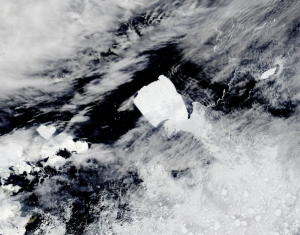Grounding near the shallow continental shelf close to South Georgia could block off routes between feeding and breeding areas for many penguin and seal colonies.
在靠近南喬治亞島的淺大陸架附近擱淺,可能會阻斷許多企鵝和海豹群體往返覓食區和繁殖區的路線。
This disruption "forces the adults to swim further, burn more energy and, basically, bring back less," says Meijers, resulting in higher mortality and potentially worsening the impact of bird flu on both seals and penguins
邁耶斯說,這種干擾“迫使成年動物游得更遠,消耗更多能量,基本上帶回的食物也更少”,這將導致更高的死亡率,并可能加劇禽流感對海豹和企鵝的影響。
Timing is important. "In October, the penguins decide where they're going to nest," says Maria Vernet, a marine ecologist at Scripps Institution of Oceanography, UC San Diego.
時機很重要。加州大學圣地亞哥分校斯克里普斯海洋研究所的海洋生態學家瑪麗亞·韋爾內說:“10月,企鵝會決定在哪里筑巢。”
An enormous, steep iceberg that's "more like an apartment building," is a bigger threat when the eggs and chicks are in the nest and utterly dependent on their parents.
當蛋和雛鳥還在巢中,完全依賴父母時,這座“更像公寓樓”的巨大陡峭冰山,會構成更大的威脅。
"But by February, all those chicks should be out of their nest" and can forage for themselves, she says.
但她說:“到2月,所有雛鳥都應該離巢了”,可以自己覓食。
There are other potential impacts.
此外還有其他潛在影響。
In 2000, the B15 iceberg calved off the Ross Ice Shelf and acted "like a shield," says Vernet, reducing the amount of light that could penetrate the ocean and reduced the growth of phytoplankton -- which forms the base of the food web.
韋爾內說,2000年,B15冰山從羅斯冰架脫離,它“像一個屏障”,減少了能夠穿透海洋的光線量,抑制了浮游植物的生長,而浮游植物是食物網的基礎。
On the flip side, as the iceberg melts, it deposits iron that it picked up from grinding along the seabed, and stirs up deep waters, bringing rich nutrients to the surface.
另一方面,隨著冰山融化,它會釋放從海底摩擦中獲得的鐵,并攪動深層海水,將豐富的營養物質帶到海面。
This encourages plankton blooms, "which attract krill, which then support pretty much everything in the Southern Ocean," says Meijers.
邁耶斯說,這會促進浮游生物大量繁殖,“吸引磷蝦,進而為南大洋的幾乎所有生物提供食物”。
"Drifting icebergs generate a little ecosystem with them," says Vernet.
韋爾內說:“漂移的冰山會形成一個小型生態系統。”

If it brings the krill close to the rookeries, the penguins would have a feast.
如果它把磷蝦帶到靠近繁殖地的地方,企鵝就有大餐可吃了。
"The ocean current is a series of complex, interconnected eddies," says Siegert.
西格特說:“洋流是一系列復雜且相互關聯的漩渦。
"The average flow is in a certain direction, but it's really complicated," making it nearly impossible to predict where icebergs will drift.
平均流向是某個方向,但實際情況非常復雜。”這使得幾乎無法預測冰山會漂向何處。
Several icebergs have followed a similar path: in 2004, A38 grounded on South Georgia's continental shelf with catastrophic wildlife impacts, A68 melted and missed South Georgia in 2020–2021, and, in 2023, A76 broke into smaller pieces in the waters around the island.
有幾座冰山走過類似的路線:2004年,A38在南喬治亞島的大陸架擱淺,對野生動物造成了災難性影響;2020-2021年,A68融化并錯過了南喬治亞島;2023年,A76在該島周圍水域分裂成較小的碎片。
If A23a breaks up, it could be dangerous for ships navigating the treacherous Southern Ocean.
如果A23a解體,對于在險惡的南大洋航行的船只來說可能很危險。
"It's the stormiest, most unpleasant ocean in the world," says Siegert.
西格特說:“這是世界上風暴最頻繁、最惡劣的海洋。”
It's easy to track a slab of ice twice the size of London, but following a series of smaller icebergs is much harder. Plus, these can suddenly overturn.
追蹤一塊兩倍于倫敦大小的冰塊很容易,但追蹤一系列較小的冰山要困難得多。而且,這些小冰山可能會突然翻轉。



